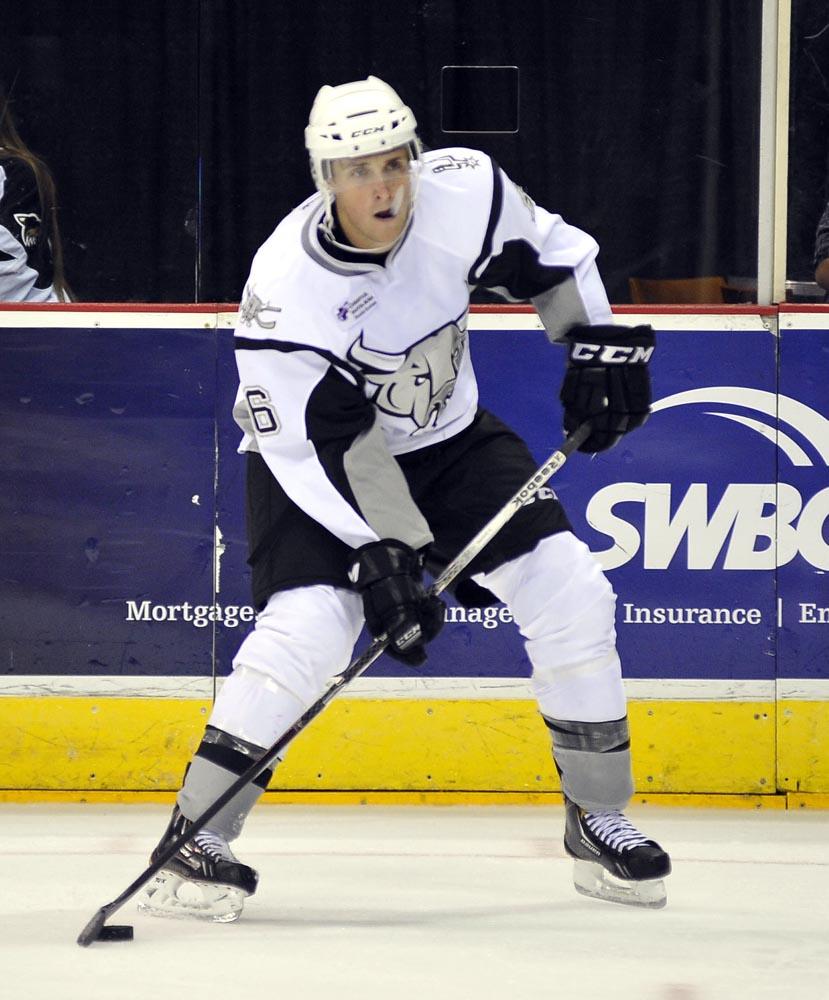by Kristian Limas || AHL On The Beat Archive
It’s a little less than an hour before game time and San Antonio Rampage rookie forward Drew Shore is already hard at work.
His process is simple, but precise. The series of sprints, leg kicks, and lunges are all a routine effort to loosen up before he hits the ice and, more importantly, to mentally prepare for the game ahead.
This is evident when a team employee reminds him of an interview set for the following week. Shore stops his routine, but only for a second, merely to acknowledge that he heard the request.
“Yeah, sounds good,” he says as he reaches for an elastic band. The employee reminds him that he’d like to sit down with him on Tuesday, not just the usual post-practice media scrum.
“Got it,” he says as he starts another set of stretches, his words a tinged with a “not now” tone. This is his time, and he makes it known by starting his sprinting regiment down the hallway.
He certainly doesn’t mean to be rude; he just has a job to do. And so far into his first professional season, he’s been doing it well.
Through 17 games Shore is tied atop the Rampage’s scoring list with 14 points (five goals, nine assists) and most recently potted two goals and an assist in San Antonio’s 5-3 loss to the Texas Stars.
The Florida Panther’s second-round pick (44th overall) in the 2009 NHL Entry Draft can skate and score like a lot of other high round draft picks. But what has set Shore apart is his sheer determination to rise through the ranks and ultimately play in the NHL, a goal he set at a young age.
It all started with a jersey. It was a Christmas gift for a three-year-old Drew who was just starting to gravitate towards the game. Little did he know, hockey would soon consume him and his three younger brothers.
“A couple of my dad’s buddies played hockey, so I started getting into it from them,” said Shore. “I got a jersey for Christmas when I was three and it just went from there.”
It was a rather serendipitous start for the youngster considering neither of his parents knew much about hockey. Shore’s mother grew up in Florida playing tennis and swimming while his father was a lacrosse player at Connecticut College.
Although the game was somewhat foreign to them, Shore’s parents encouraged Drew to participate in the sport. Like so many who get into the game at a young age, hockey provided a fun and competitive outlet for Drew.
He continued to improve through the youth hockey ranks in his hometown of Denver, often the standout player on his team. By the time he turned 15, Shore was receiving looks from scouts who wanted to tap into his on-ice prowess.
He had quickly outgrown the youth leagues in Denver and it had become apparent that his skill was enough to help him take the next step towards his ultimate goal of being a professional hockey player.
“I left home when I was in eighth grade,” Shore said. “I went to Canada for two years, and then I was in Michigan through most of high school.”
In Ann Arbor, Mich., Shore was a part of the U.S. National Team Development Program, the elite training ground for American-born hockey players. Run by USA Hockey, the national governing body for the game, it selects the top young players from across the country to enter the program, which has notable NHL alumni like Patrick Kane and Phil Kessel.
Shore represented his country for two years (2007-09) and donned the red, white and blue in both the Under-17 and Under-18 international tournaments.
By the end of his stint with the NTDP, Shore was one of the top prospects in the country. He had his choice of any top collegiate hockey program to attend and was even drafted in the second round of the Western Hockey League draft.
With options aplenty, Shore knew where he wanted to be– back home in Denver. He received a full scholarship to play hockey at Denver University, one of the most prestigious collegiate hockey programs and a seven-time national championship winner, second to only the University of Michigan.
“I had actually learned to skate at DU when I was first starting out,” said Shore, whose parents coincidentally met while attending law school at Denver University. “It was great to go back there to play my college hockey.”
Shore saw limited ice time his freshman year, as the Pioneers were ranked first in the nation through most of the season and were led by several veteran forwards. During his sophomore year he was the Pioneer’s leading scorer, jumping from just 19 points his first year to 46 in 40 games. He also earned a bronze medal with Team USA in the World Junior Championship.
Shore was quickly making a name for himself in the college ranks, a feat that was no surprise to the man who recruited him, Denver head coach George Gwozdecky.
“Drew is one of those guys who has always impressed me because he knows what he wants to do and how to get there,” Gwozdecky said. “From a young age he set his goal of becoming a professional hockey player.”
Shore’s junior year can best be described in one word: dominant. He again lead the Pioneers in scoring with 53 points (22 goals, 31 assists) in 42 games and served as captain as one of the best teams in the nation. Personal accomplishments aside, what Shore valued the most was the chance to share the ice with his younger brother Nick, who was a freshman.
“It was awesome,” Shore said. “It’s not that often that brothers play together in college. I was glad I had that opportunity.”
At the end of his junior year Shore once again came to a crossroads. His other younger brother Quentin, was set to start his freshman year at Denver. It’s rare enough for two brothers to share the ice, let alone three.
It was a decision Drew has often cited as the toughest of his life, but in the end he decided it was time to fulfill his childhood dream of being a professional hockey player.
“Certainly school was great,” Shore said. “But to be honest if I had gone back it would have just been to play with my brothers. I realized at the end of the day that I had worked my whole life to take that next step.”
A week after losing to Ferris State in the NCAA regionals, Shore made his decision and things started happening fast. Shore hopped on a plane to San Antonio to join the Rampage, a team in the midst of a playoff run. It was all very surreal for Shore, but it didn’t quite register until he touched down in the Alamo City for the first time.
“It was 90 degrees and I was going to the rink in sandals, so I definitely wasn’t used to that,” Shore said. “But I was excited to back into some hockey. It was a good time to come in, too. It was the playoffs so it was really competitive hockey.”
“It was an easy transition,” he added. “The guys were really good to me and I felt like a part of the team right away.”
Shore played in 17 games for the Rampage last season. Nine of those were in the Calder Cup Playoffs where he scored two goals and was part of the team that won its first playoff round in franchise history.
Needless to say, being a part of that playoff run last year has paid dividends this year.
“Just being comfortable coming down here,” Shore said. “As an offensive guy, confidence is a huge thing. Having that confidence makes things so much easier and I think coming in and playing in the playoffs gave me a little bit of extra confidence coming into this year.”
Shore may call it confidence, but when you ask his teammates and coaches, they will tell you the same thing everybody has been saying about Shore since he was young: He knows how to work.
“As a young guy he’s understanding what it takes to be a professional hockey player,” Rampage head coach Chuck Weber said. “He puts the extra work in weight room before and after practice. He’s being rewarded for that.
“He’s a guy who plays with a lot of a pace in his game and he wants the puck. You have to give credit to him for wanting to be an impact guy.”
Back in the tunnel Shore is suited up and ready to go. He’s yelling and high-fiving his teammates, just getting ready for another night of work. One day he hopes that it’ll be NHL ice that he’s leading the charge onto. But for now, here in San Antonio, there’s still plenty of work to be done.






































